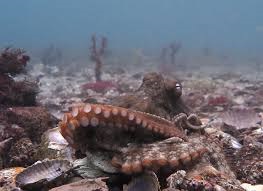Octopuses have generally been viewed as solitary creatures–and their color-changing abilities primarily as a means to hide from hungry predators. But, after binge watching more than 52 hours of octopus TV, researchers reporting have found that octopuses actually do have a social life. And it’s not without drama.
“We found that octopuses are using body patterns and postures to signal to each other during disputes,” says David Scheel. “The postures and patterns can be quite flashy, such as standing very tall, raising the body mantle high above the eyes, and turning very dark.”
Scheel along with colleagues noticed some intriguing patterns: when an octopus with a dark body color approached another dark octopus, the interaction was more likely to escalate to grappling. When a dark octopus approached a paler one, the pastier octopus more often retreated. When the opposite happened and a light octopus approached a darker one, the latter more often stood its ground.
“Dark color appears to be associated with aggression, while paler colors accompany retreat,” Scheel says.
Octopuses also displayed on high ground, standing with their web spread and their mantle elevated. Octopuses in that “stand tall” posture frequently also sought higher ground. The researchers suspect the octopuses’ behaviors are meant to make themselves appear larger and more conspicuous.
The findings expand scientists’ understanding of how octopuses interact and communicate with each other. The researchers now suspect that social interactions among octopuses are likely to occur wherever food is plentiful and hiding places are scarce. They’ll continue to study these octopuses and to explore how their social live.
Source: Science daily
N.H.Khider

